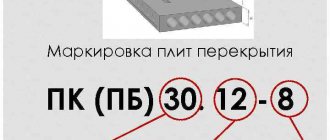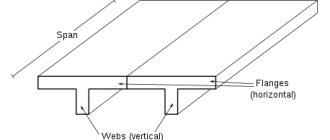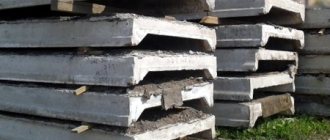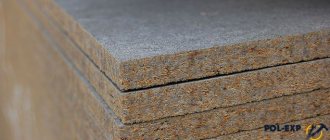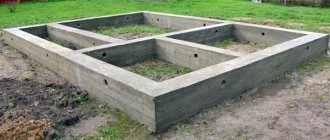Reinforced concrete fence slab is one of the most popular materials in fencing construction. Precast concrete slabs are used to construct a reliable wall around construction sites, industrial areas, large warehouses, and various closed facilities.
An example of a classic slab fence
In earlier times, such a fence looked exclusively like a massive gray structure. In contrast to the proposals of previous years, modern production trends make it possible to produce beautiful products of different weights and structures, which provides buyers with a large selection of decorated reinforced concrete panels. Return to contents
Types and characteristics
Fence slabs presented on construction markets may be different. Products differ in size, design characteristics, installation method and external characteristics. Concrete slabs are usually divided into three types:
- Eurofences;
- Block panels;
- Tile products.
Eurofences differ from panel blocks and slabs in that they are lighter in weight. This makes it possible to install the fence without the involvement of special vehicles. These concrete fences are sections with a patterned structure and an interior reinforced with rolled metal.
This is what a lighter euro-fence made of concrete looks like.
The average size of a euro-panel unit is 2000 mm in length and 500 mm in height.
The weight of the products does not exceed 90 kg. Europanels are a universal option. They are beautiful, varied in texture and color, as well as durable and of high quality, like any concrete building material. These fence slabs are easy to install. They either thread into one another or are fixed with special grooves in the support pillars. Concrete euroslabs are the most popular products among private owners. They are the ones most often given preference when constructing fences around the house and in summer cottages. A fence made of block panels is made according to the principle of building a brick fence. Blocks can be hollow or reinforced. Their color range is wide, providing a solution to any requirement. Many manufacturers produce products of this type with a decorative coating, which makes them even more attractive to buyers.
Different types of concrete fence slabs
Concrete slabs have standard sizes, which depend on their markings. So, for example, a reinforced concrete panel marked 2PB 30-16 has the following parameters:
- Weight is 1200 kg;
- Length - 2980 mm;
- Height - 1600 mm;
- Width - 120 mm.
Fences made of large reinforced concrete slabs are most often used to fence off industrial areas and closed facilities. Due to their heavy weight, their installation requires special equipment. And the price is higher than the price of euroslabs or decorative concrete blocks. Today, buyers most often purchase European standard concrete slabs. Such fence slabs allow calculations and installation to be carried out quickly and efficiently, without additional adjustments or the use of special machines. Installation is carried out in the provided or other elements of the fence, which ensures perfect fixation of the finished structure. Installation can be done by two or four people.
An example of installing a plate in a glass
If the fence is planned to be low, for decorative purposes, then one worker can handle its construction. Return to contents
Reinforced concrete slabs for fences as a noticeable component of the entire range of reinforced concrete products
Often, temporarily installed reinforced concrete fences remain in place much longer than the originally expected period - reliability is the main factor here
Some very authoritative experts in the “construction sciences” seriously consider the invention of reinforced concrete to be the most important achievement of the 20th century in construction. And this is worth believing, especially considering the so popular monolithic reinforced concrete construction.
Despite all the incidents and difficulties of the existence of large production plants, concrete factories have never felt a lack of customer attention. Among the entire range of products they produce, fencing slabs stand out.
It is quite possible that these products are one of the favorite products of the manufacturers themselves - this is where you can show creative ingenuity, given that these fence slabs do not differ in particular variety of appearance.
If the overwhelming majority of reinforced concrete products have generally accepted standard sizes, determined by state standards, then in the production of slabs, each manufacturer has the right to show and does show his design inclinations.
Although there are still more slabs in use in two sizes:
- PB40.20: length: 4000 mm (4 meters);
- height: 2000 mm (2 m);
- thickness: 160 mm (16 cm);
- weight: 1.7 t (1700 kg).
- length: 3000 mm (3 meters);
- height: 2000 mm (2 m);
- thickness: 120 mm (12 cm);
- weight: 1.3 t (1300 kg).
- PB30.20: Here, however, you have to keep in mind two factors:
- By and large, there are no strict uniform standards for geometric dimensions . The market does not particularly respect the dimensions of fence slabs; each manufacturer is free to produce products according to their own sizes. Here you have to mostly rely on the prudence and foresight of the manufacturers. If the P6V fence slab is the most popular in your region, this is only due to the specialization of the reinforced concrete plant.
- The second factor is related to the labeling of products, their huge assortment and the fragmentation of the markets of the former united countries of the Soviet Union . The given PB markings apply to Ukraine. For example, in Russia PB40.20 slabs are better known under the P5 marking.
Fence slabs are not just a 3 by 2 rectangle - the number of different shape options is huge and often depends on the imagination of the manufacturer
Helpful advice! If you have decided to install a new permanent fence around your territory and think that the P6V fence slab can help you with this, first of all contact a reinforced concrete plant. Only there can you finally be informed of the entire range of fences produced and their sizes. You should not make any plans without thoroughly studying the market of offers from manufacturers. Be sure to get acquainted with the work already completed - the performer of your work must have sufficient experience and at least a powerful crane to work with scales up to 3 tons. The weight of the fence slab can range from 500 kg to 2000, depending on the size.
Installation of fences
Reinforced concrete fences will last for many years, performing their assigned functions only if they are installed correctly. Professional installation can be ordered from specialized companies or construction trade sites. Those who prefer to do everything with their own hands can install a fence from euroslabs themselves. Installation of a concrete fence requires precise calculations and careful preparation.
Reinforced concrete walls require preliminary concreting of pillars that serve as supports for the sections.
Fastening the fence slab involves installing each element on a support from above. If you follow the general installation rules and take a responsible approach to its implementation, you can build a high-quality fence from a sectional slab on your own.
Return to contents
Competition is growing
Of course, before deciding to install a fence made of slabs, you will carefully study all the proposals; installation instructions most likely will not interest you - such bulky structures, even prefabricated ones, cannot be created with your own hands.
However, it doesn’t hurt to get acquainted with all the photo materials at your disposal; be sure to watch the video in this article.
Stacked decorative sections help reduce the “working” weight of one product and increase the mobility of the entire assembly process
But keep in mind that the market is growing quite quickly. And it’s no longer uncommon to come across very exotic offers - fences from Poland, Argentina, Brazil. Evaluate all the options that interest you and make an informed decision. Moreover, keep in mind that the main costs will have to be attributed not to the purchase of the fencing structures themselves, but to their installation, in which the lion's share will be occupied by the rental of special equipment.
Basic installation rules
Since europlates may differ in the principle of fixation, and the fence itself does not always require pouring a foundation, the methods of their installation have some differences. However, there are several simple and general rules, the observance of which will make the work easier, and its results will meet expectations. General rules:
- Since not every piece of land is level, you need to determine the approximate angle of its slope. If the slope is noticeable and the area is very uneven, a “stepped” installation should be performed. With such a wall arrangement, the fence slab will differ from one another at the upper edge of the spans. In this case, the distance from the ground at the bottom of the sections will remain the same.
- The reinforced concrete fence slab must be installed efficiently. To do this, it is necessary to assess the properties of the soil and determine the topography of the perimeter of the future fence.
The climatic features of the region are also taken into account. Areas where heavy rainfall prevails require, during installation, a mandatory assessment of the possible impact of water flows on the intake. - Those who decide to do without the help of specialists should remember that such a fence is assembled by installing sections into grooves. For this work you need to invite at least four people.
- The reinforced concrete euroslab is 2000 mm long. When calculating, taking into account small gaps and the thickness of the pillar lintels, another 60 mm should be added to the length of the slab itself.
- Some slabs need to be trimmed during installation. A diamond wheel is used for this work.
- When planning the construction of a Eurofence with your own hands, you should take into account the cross-section of the support (150 x 150).
Return to contents
Equipment
You should also keep in mind the configuration, even despite such a seemingly simple design material:
- Firstly, the fence slab itself is 3-3, although the dimensions here will no longer be fundamental - 4-2, 2-2, or 2.5-2.5. Of the latest options, you can often find offers from Russian manufacturers:
- PZ-3: length: 2500 mm (2.5 meters);
- height: 2500 mm (2.5 m);
- thickness: 120 mm (12 cm);
- weight: 1398 kg.
- length: 2100 mm (2.1 meters);
- Secondly, installation posts, if you have chosen a prefabricated fencing option;
- Thirdly, the so-called glasses for the foundation of the fence slab. Today, installing such options is one of the most popular. The most famous in terms of their size are two types of glasses, which ensure the stability of the entire fence structure:
- Ф9.7.5: length: 900 mm (90 cm);
- width: 700 mm (70 cm);
- height: 450 mm (45 cm);
- weight: 480 kg.
- length: 1200 mm (120 cm);
Such simple reinforced concrete products are very convenient for storage and transportation.
- Fourthly, a cover plate for the fence. This product is rarely used and is considered a decorative finishing material for finishing the top line of the slab. Among the most common sizes of cover covers: 30 x 50 mm;
- 45 x 45 mm;
- 55 x 55 mm;
- 38 x 50 mm;
- 45 x 50 mm;
- 55 x 50 mm.
- Fifthly, a cover for the fence posts. Also applies to decorative materials. The dimensions of such covers largely depend on the range of posts produced, but the most common sizes will be the following: 446 x 446 x 120 mm;
- 495 x 180 x 45 mm;
- 390 x 270 x 55 mm;
- 390 x 350 x 68 mm.
Fence slabs of any reliable design cannot do without special glasses - the main thing is to coordinate the dimensions of the glass with the dimensions of the product
Helpful advice ! When delving into the nature of the production of slabs for fencing areas, be sure to find out the brand and class of concrete from which the product was made. The most common type for these purposes is considered to be M 200, and the class is B 15. You should not use stronger concrete, this will lead to an unjustified increase in the cost of the entire product without a corresponding increase in its reliability. Do not allow the use of a lighter one; after all, you are installing a reinforced concrete fence, and not a “fence for rabbits”.
Channel-type products have long been familiar to everyone - without the use of glasses. But large-scale excavation work is required
Three useful notes for practical
There are three more nuances that are very useful to keep in mind:
- For quite a long time, simpler designs of reinforced concrete fences, the so-called channel type, were in use.. For such fences, it was necessary to carry out excavation work to create a ditch in the foundation (ground) to install the fence. Nowadays, even in this area, “service” has gone a little ahead and fences “on glasses” dominate, but the old ones are still in demand due to their, sometimes, bargain prices. The price for them can be an order of magnitude less - if for a new stove for a glass, approximately 5,000 rubles, then for a “duct” - no more than 1,000.
Often used products are quite suitable for temporary installation.
- If you want to save even more, you can try installing a previously used fence slab. They can still serve, especially for temporary purposes, and you will get them for a completely symbolic fee - “for pickup.”
- Well, a very attractive option is prefabricated fence structures made from products of a smaller size in height. They are installed in the grooves of fence posts and offer more design possibilities. At each level, you are free to choose slabs of a different color and texture - the so-called decorative sets.
But time moves forward, and new offers begin to appear on the building materials market. A reinforced concrete fence made from such products can already satisfy the most demanding requirements.
Features of arranging a fence made of concrete slabs
A fence made of concrete is one of the most reliable types of fencing. And if in not so long ago such fences had an unattractive appearance and were used mainly for fences at industrial enterprises, then with the development of modern technologies, concrete fence slabs began to look completely different. They are beautiful, durable, and therefore very popular among owners of private houses. To install such a fence, it is worth knowing the features of concrete slabs and the subtleties of their installation. It is useful to familiarize yourself with the foundation for the fence and its structure.
Types of concrete slabs
Modern concrete fences can be different in design, size, appearance, and installation method. They are divided into 3 main types:
Tiled fences are built from standard monolithic sections. The standard fence slab has dimensions in accordance with the standards indicated in the table. They depend on the marking:
Such slabs are produced both with and without special legs. Special glasses are provided for installation to ensure reliable fastening and support for the fence.
Important! A special feature of installing fencing from monolithic sections of the specified sizes is the use of special equipment due to the large weight of each product.
The price of monolithic fence slabs is low, they are affordable and quite reliable in operation. The material for the manufacture of concrete slabs is heavy grade concrete. Additionally, the product is reinforced with a welded structure made of rolled metal. This manufacturing technology guarantees high strength of the product.
Do you know what grade of concrete is needed for laying a strip foundation?
Creating a block fence is similar to creating a brick fence, only instead of it there are blocks. Blocks can be either hollow or reinforced. They come in different colors, and quite often you can see an additional decorative coating applied to such fences.
The most modern concrete fence is the Eurofence. It is quite close both in production method and quality to standard concrete fencing. The dimensions of one product are 2000 x 500 mm, such a fence slab has a small weight - up to 90 kg. Thanks to this, it can be easily installed without the use of special equipment. Typically, the appearance of Eurofence sections imitates natural materials - stone, wood, vine. The sections are internally reinforced with rolled metal. Slabs with a patterned structure are also produced as an additional decorative finish. The construction of a eurofence is carried out by laying sections one on top of another.
Advantages and disadvantages of a concrete fence
The production of concrete fence slabs is a fairly promising type of business due to the constantly growing demand for such products. The demand is due to obvious advantages:
- long service life,
- low cost - both of the concrete slabs themselves and of the construction work,
- fire safety,
- ease of repair - all you need to do is replace the damaged slab,
Important! An exception to this clause is block fences due to a different construction technology.
- arrangement of a fence of any height - this is especially important if you want to create a high fence, which is impossible or expensive when using other materials,
- high speed of fencing construction,
- no need to install an expensive monolithic foundation,
- independence during installation from the terrain and soil of the site,
- resistance to the harmful effects of the environment and atmospheric phenomena,
- ensuring high sound insulation,
- all material is interchangeable and complementary,
- high stability - due to the large weight of the slab,
- variety of design solutions.
There are few disadvantages, but they exist:
- the area enclosed by such a fence is poorly ventilated,
- when the soil shifts, sections may fall out or be damaged,
- the reverse side of the concrete fence is monotonous and inexpressive, which can be solved with the help of additional finishing.
Nuances of choosing concrete slabs
Even before you decide to build a concrete fence, you should carefully consider the photo of the fence slab. This will help you decide both on the size and amount of material required, and on the design of the slabs.
After all sections have been delivered to the installation site, they should be carefully inspected. It is unacceptable to use products that have chips or cracks. Subsequently, such defects will create the possibility of destruction of the structure, and the fence itself will require repairs.
If you request slabs with a color scheme, then you need to check for uniformity of shade throughout the entire batch. When a colored fence board is required, it is produced by adding a coloring agent; the percentage of such an additive can be changed depending on the batch.
Important! You can often find recommendations for making concrete slabs yourself. But if you do not have sufficient experience in their production, then the best solution would be to purchase factory products - this way you will get sections that meet the stated standards.
If your goal is to build a tall, strong fence that also has a long service life, then a concrete fence would be the best choice. Its cost is comparable to that of other materials, but in other qualities it surpasses all known materials.
Weight of fence slabs
home ⇒ construction mat ⇒ reinforced concrete ⇒ slabs
When constructing fencing structures around objects for various purposes, concrete fence slabs with a length of 3.98 (m), a thickness of 0.16 (m), a height of 2.2 (m), and a weight of 1600 (kg) are often used.
Weight of a reinforced concrete fence slab, dimensions are indicated in the “length/thickness/height” format:
- P-6VA 3980x160x2200 (mm) – 1600 (kg).
Weight of reinforced concrete posts for fencing:
- C - 3B 3000x140x140 (mm) - 150 (kg);
- SS (with grooves) 3800x250x250 (mm) – 440 (kg).
Weight of reinforced concrete supports for fencing:
- AF-1 800x800x400 (mm) – 250 (kg);
- FB-1 800x800x500 (mm) – 400 (kg).
Important: the production of concrete fence elements is regulated by GOST 12767-94, GOST 13579-78, TU 67-07-232-89.
Total weight of fence slabs Drawing Drawing and parameters of a standard model Slab (kg) Weight of the P-6VA slab in (kg) Stand (kg) Weight of the AF-1 slab stand in (kg) Post (kg) Weight of the S-3V fence post in (kg )
| Fence | 160 (kg) | 250 (kg) | 150 (kg) |
Table of mass of reinforced concrete fence elements Brand Brand of product m (kg) Weight of product in (kg) v (m3) Volume of product in (m3)
| Stove P-6VA | 1,60 | 0,64 |
| Stand AF-1 | 0,250 | 0,10 |
| Stand FB-1 | 0,400 | 0,16 |
| Column C - 3B | 0,150 | 0,06 |
| SS post with grooves | 0,44 | 0,18 |
wikiweight.info
Advantages of panel fencing
Having considered several types of modular fences, we can highlight several significant advantages of structures of this type:
- Easy installation and dismantling. Modular systems are quickly assembled, which is convenient when a fence needs to be installed with minimal time. It can also be quickly dismantled when there is no longer a need to use such a fence.
- Easy replacement of a faulty fence part. Whether it is a section or a panel, it can be easily replaced with another.
- Attractive appearance. Panel fencing and fences can come in a wide variety of shapes, structures, textures and colors.
- Wide range of applications. Panel fences are an excellent solution for fencing any areas of land for various purposes.
Metal panel diagram
